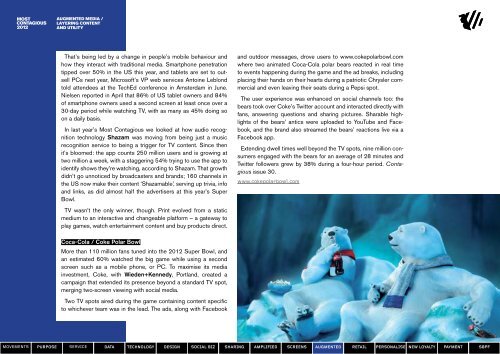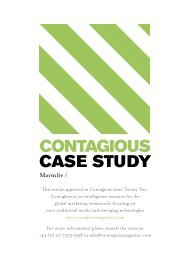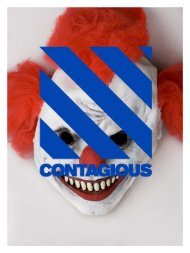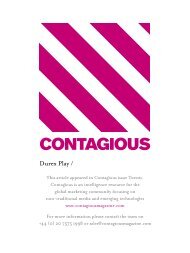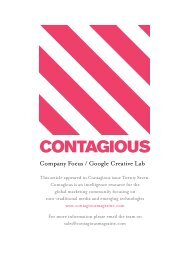MostContagious2012.pdf - Contagious Magazine
MostContagious2012.pdf - Contagious Magazine
MostContagious2012.pdf - Contagious Magazine
You also want an ePaper? Increase the reach of your titles
YUMPU automatically turns print PDFs into web optimized ePapers that Google loves.
augMented Media /<br />
layering content<br />
and utility<br />
That’s being led by a change in people’s mobile behaviour and<br />
how they interact with traditional media. Smartphone penetration<br />
tipped over 50% in the US this year, and tablets are set to outsell<br />
PCs next year, Microsoft’s VP web services Antoine Leblond<br />
told attendees at the TechEd conference in Amsterdam in June.<br />
Nielsen reported in April that 86% of US tablet owners and 84%<br />
of smartphone owners used a second screen at least once over a<br />
30-day period while watching TV, with as many as 45% doing so<br />
on a daily basis.<br />
In last year’s Most <strong>Contagious</strong> we looked at how audio recognition<br />
technology Shazam was moving from being just a music<br />
recognition service to being a trigger for TV content. Since then<br />
it’s bloomed: the app counts 250 million users and is growing at<br />
two million a week, with a staggering 54% trying to use the app to<br />
identify shows they’re watching, according to Shazam. That growth<br />
didn’t go unnoticed by broadcasters and brands; 160 channels in<br />
the US now make their content ‘Shazamable’, serving up trivia, info<br />
and links, as did almost half the advertisers at this year’s Super<br />
Bowl.<br />
TV wasn’t the only winner, though. Print evolved from a static<br />
medium to an interactive and changeable platform – a gateway to<br />
play games, watch entertainment content and buy products direct.<br />
Coca-Cola / Coke Polar Bowl<br />
More than 110 million fans tuned into the 2012 Super Bowl, and<br />
an estimated 60% watched the big game while using a second<br />
screen such as a mobile phone, or PC. To maximise its media<br />
investment, Coke, with Wieden+Kennedy, Portland, created a<br />
campaign that extended its presence beyond a standard TV spot,<br />
merging two-screen viewing with social media.<br />
Two TV spots aired during the game containing content specific<br />
to whichever team was in the lead. The ads, along with Facebook<br />
and outdoor messages, drove users to www.cokepolarbowl.com<br />
where two animated Coca-Cola polar bears reacted in real time<br />
to events happening during the game and the ad breaks, including<br />
placing their hands on their hearts during a patriotic Chrysler commercial<br />
and even leaving their seats during a Pepsi spot.<br />
The user experience was enhanced on social channels too: the<br />
bears took over Coke’s Twitter account and interacted directly with<br />
fans, answering questions and sharing pictures. Sharable highlights<br />
of the bears’ antics were uploaded to YouTube and Facebook,<br />
and the brand also streamed the bears’ reactions live via a<br />
Facebook app.<br />
Extending dwell times well beyond the TV spots, nine million consumers<br />
engaged with the bears for an average of 28 minutes and<br />
Twitter followers grew by 38% during a four-hour period. <strong>Contagious</strong><br />
issue 30.<br />
www.cokepolarbowl.com<br />
MOVEMENTs purpose sErVicE data technology design social biz sharing amplified screens augmented retail personalise new loyalty payment sbpf


